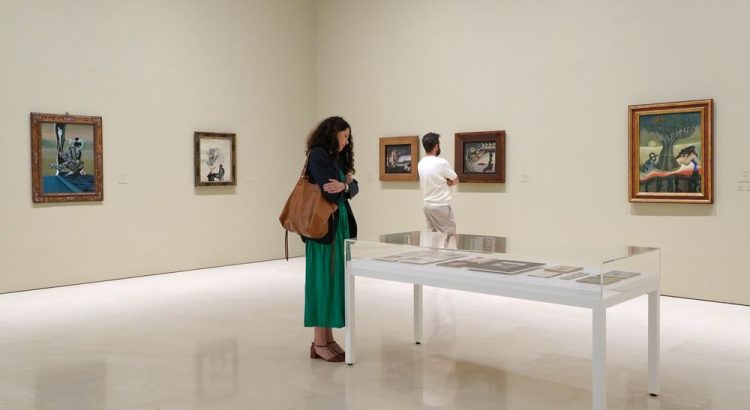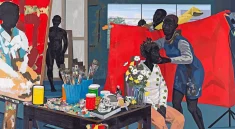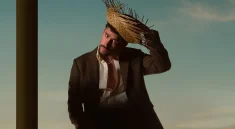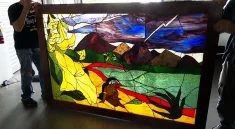Robert Draws – Óscar Domínguez at Museo Picasso Málaga arrives as a vibrant tribute to a surrealist figure whose legacy had been overshadowed by time. The exhibition pays homage to the Spanish artist until 13 October 2025 by presenting more than one hundred artworks. Among these are his innovative decalcomania pieces and collaborations with André Breton and Pablo Picasso.
This immersive showcase celebrates his crucial role in the anti Nazi resistance movement while acknowledging the controversies surrounding his personal life. Visitors will find themselves immersed in a world where dreamlike imagery confronts harsh political realities and where experimental technique blends with defiant spirit. The exhibition spans different periods of Domínguez career to reveal his evolution as artist and activist. Evocative installations and painted panels guide observers through visual narratives that intertwine surrealist exploration, historical turbulence and creative collaboration. Through passionate curation this retrospective restores Domínguez to his rightful place in art history.
Decalcomania and Artistic Innovation
Óscar Domínguez at Museo Picasso Málaga highlights the decalcomania method that he pioneered in the late 1930s. This unique technique involved applying paint on one surface and pressing it onto another to create spontaneous textures and forms. Visitors encounter dozens of decalcomania prints that reveal a range of organic patterns suggesting underwater worlds, barren landscapes and alien creatures. Works created with Breton and Picasso offer insight into Domínguez experimental mind that thrived on collaborative exchange. His process challenged conventional painting by embracing chance and subconscious expression. This section also displays preparatory sketches that document the development of his vision and method. Curators placed emphasis on technique by allowing museum goers to view close up textures. The result is a visceral appreciation for artistic risk and creative authenticity in Domínguez practice.
“Read about: The Herds Take Over London Streets with a Climate Warning”
Collaboration with Breton and Picasso
Óscar Domínguez at Museo Picasso Málaga documents the unique creative relationships that defined his surrealist identity. Exhibited pieces created in dialogue with André Breton highlight Domínguez radical position within the surrealist movement. He responded to Breton ideas by producing art that blurred boundaries between dream and reality. Collaborative works with Picasso, in turn, reveal mutual influence between two avant garde minds. In one room museum visitors encounter side by side canvases that show how Domínguez style evolved through such artistic synergy. Personal letters and archival materials enrich understanding of these collaborations by offering context to each creative exchange. The curatorial narrative showcases how Domínguez rejected aesthetic orthodoxy to pursue an idiosyncratic vision. The combined presence of these works in the exhibition underscores his relevance within the broader network of European avant garde art that shaped twentieth century visual culture.
Surrealism and Anti Nazi Resistance
A striking feature of the exhibition is the way political resistance and surrealist ideology are intertwined in Domínguez legacy. This section reveals the artist active opposition to the Nazi regime during the Spanish civil war and second world war. Propaganda like posters and underground illustrations demonstrate his commitment to freedom and justice. These powerful graphic works appear alongside surrealist paintings to illustrate how political engagement informed Domínguez visual vocabulary. He used surrealism as weapon against tyranny and oppression. Eye catching murals and canvas work emphasize his ability to transform tragic events into evocative imagery. The museum atmosphere supports a sense of urgency and moral conviction in Domínguez work. His courage and vision defied fascist forces and enriched surrealism with a dimension of activism rarely acknowledged in mainstream art history.
“Read more: Human Trafficking Thrives Where Policies Fail, Says GRETA’s 2024 Review”
Controversy and Personal Life Explored
Museum audiences will witness the complexities of Domínguez character through intimate portraits and personal artifacts. This section of the exhibition does not shy away from the more controversial aspects of his life including struggles with addiction and erratic behavior that overshadowed some of his later achievements. Candid biographical materials illustrate how he was both brilliant and unstable, a genius overshadowed by inner turmoil. Family photographs and personal letters offer glimpses into relationships strained by his obsession with art and fame. The curators chose to present this raw portrait to shed light on the intimate struggle behind Domínguez creativity. By integrating personal tragedy with artistic exploration the exhibition invites audience to empathize with the contradictions that shaped his art. This honest approach fosters deeper connection to the man behind surrealist fantasy.
Legacy Restored Through Public Engagement
The final segment of the show invites visitors to engage directly with Domínguez ongoing influence on contemporary art. A series of workshops and talks enables attendees to experiment with decalcomania while learning about techniques that inspired later generations. Interactive installations allow participants to produce their own abstract prints in the style of Domínguez. Special lectures by art historians explore the artist impact on visual culture and resistance art. A digital wall showcases contemporary artists whose work can be traced back to his experimental methods. The public programming emphasizes that Domínguez legacy remains alive within surrealist practice and beyond. Full integration of audience participation encourages museum goers to become part of Domínguez story and ensures that this long overlooked art will continue inspiring new creative explorations.



